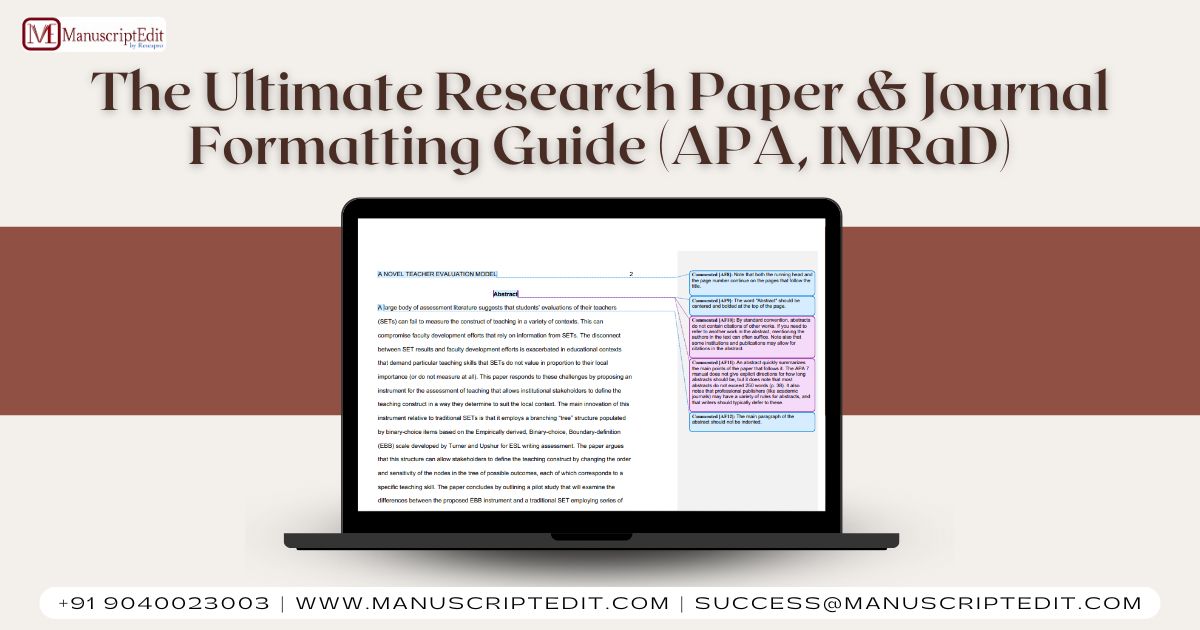Why Proper Formatting is Your Secret Weapon

Envision worked for months on innovative research, only to have your research paper rejected due to formatting issues. Thousands of submissions go to journals, and editors routinely reject poorly formatted papers without regard to how good the content is. Proper formatting:
- Demonstrates professionalism: Editors believe sloppy formatting indicates sloppy science.
- Makes your work easier to read: Clear headings, citations, and organization enable reviewers to concentrate on your ideas.
- Meets journal guidelines: Numerous journals will auto-reject articles that disregard formatting guidelines.
Real-World Example: In 2020, researchers discovered that 45% of desk rejections were the result of formatting errors such as improper margins, citation styles, or omitting abstracts.
Pro Tip: When formatting overwhelms you, hire manuscript editing services or journal formatting services. Professionals will perfect your paper to exacting standards, giving you time and peace of mind.
APA Format: The Gold Standard for Social Sciences
What is APA Style?
APA (American Psychological Association) is a widely used formatting style in psychology, education, and social sciences. It regulates:
- In-text citations: (Author’s Last Name, Year). For example: (Smith, 2020).
- References: Full details alphabetically listed. For example:
- Smith, J. (2020). *Climate Change and Society*. Penguin Press.
- Headings: Level 1 (bold, centered), Level 2 (bold, left-aligned), etc.
Common APA Mistakes:
- Missing running head: A shortened title on every page (e.g., “CLIMATE CHANGE STUDY”).
- Abusing “et al.”: Apply “et al.” to 3+ authors in citations (Smith et al., 2020).
Improper indentation: References must be given a hanging indent (0.5 inches).
APA Research Paper Example:
Need inspiration? Download our free APA template –
which includes placeholder text for titles, abstracts, and references.
IMRaD: The Backbone of Scientific Papers
What is IMRaD?
IMRaD is an acronym for Introduction, Methods, Results, and Discussion—a format that 90% of STEM journals demand.
Why Use IMRaD?
- Editors assume it: Not following IMRaD may baffle reviewers.
- Logical progression: Leads readers from your research question to your conclusions.
How to Write Each Section:
Introduction:
- Begin with a hook (e.g., “Sleep loss plagues 30% of adults worldwide…”).
- Declare your research question and why it’s essential.
Methods:
- Describe your study design (e.g., randomized controlled trial).
- Describe participants, tools, and procedures so others can replicate your work.
Results:
- Show raw data, charts, or graphs (no interpretations here!).
- Use subheadings such as “Demographic Data” or “Statistical Analysis.”
Discussion:
- Interpret results (e.g., “Our findings suggest sleep loss impairs decision-making…”).
- Address limitations and propose future research.
IMRaD vs. Traditional Essays:
IMRaD does not include personal opinions like essays. Be objective and evidence-focused.
Writing Abstracts That Grab Attention
What to Include in Every Abstract:
- Purpose: What problem did you study?
- Methods: Briefly describe your process (e.g., “A survey of 500 college students…”).
- Key Findings: Highlight 1–2 key findings
- Conclusion: Why are your results significant?
APA Abstract Example:
This study investigated the effects of sleep loss on decision-making in healthcare professionals. We employed a mixed-methods design, surveyed 200 nurses, and had focus groups… We found a 40% drop in alertness after 12-hour shifts… These findings serve to underscore the need for shift scheduling policy modifications.
Don’t Forget Disclosures:
- Author contributions: “Author A designed the study; Author B analyzed data.”
- Funding: “This work was supported by the National Science Foundation (Grant #XYZ).”
- Ethics approval: “The University of XYZ Ethics Board approved this study.”
Sample Research Paper Outline
Follow this template to stay organized:
Title Page: Title, author names, affiliation, running head.
- Abstract: 150–250 words summarizing your study.
- Introduction:
- Background context.
- Research question/hypothesis.
- Methods:
- Participants (e.g., “100 adults aged 18–35”).
- Tools (e.g., “Survey adapted from Smith et al., 2018”).
- Results:
- Data in tables or graphs.
- Statistical tests were employed (e.g., “A t-test revealed…”)
- Discussion:
- Interpret results in light of previous research.
- Limitations (e.g., limited sample size).
- References: APA or MLA-style citations.
Template Tips:
- Use journal-specific templates if available (consult the journal’s “Author Guidelines”).
- Modify fonts (e.g., Times New Roman, 12pt) and margins (1-inch standard).
- Avoid Citation Nightmares
APA Citation Rules:
- In-text: Always use the author and year.
- Example: “Recent studies (Johnson, 2021; Lee et al., 2020) suggest…”
References: Alphabetize by the author’s last name.
Tools to Save Time:
- Zotero: Free program to auto-create citations.
- EndNote: Costly software for handling large libraries of references.
Plagiarism Pitfalls:
- Paraphrasing in error: Don’t substitute words—rewrite sentences and credit the source.
- Self-citation overload: Cite your work only when it’s directly applicable.
When to Hire Manuscript Editing Services
Professional editors correct:
- Grammar and spelling: Even minor mistakes destroy credibility.
- Formatting: APA headings, margins, citation styles.
- Clarity: Simplify jargon or confusing sentences.
Case Study: A 2022 analysis found that professionally edited papers had a 35% higher acceptance rate.
Choose a Service That Offers:
- Subject-matter experts: A biology editor for life sciences papers.
- Fast turnaround: 3–5 days for urgent submissions.
Final Submission Checklist
Before hitting “submit,” check:
- Formatting: Margins, fonts, headings, page numbers.
- Abstract: Structured/unstructured, word count.
- Citations: All sources credited (APA/MLA).
- Disclosures: Funding, ethics approval, conflicts of interest.
Time-Saving Tools:
- Grammarly: Correct typos and punctuation.
- Hemingway Editor: Make complex sentences simpler (target Grade 8–10 reading level).
- Plagiarism Checkers: Turnitin or Scribbr to prevent accidental copying.
Key Takeaways
- Formatting counts: Be strict with APA or journal guidelines.
- IMRaD structure: Introduction, Methods, Results, Discussion.
- Refine your abstract: Use subheadings.
- Disclose everything: Funding, ethics, and author roles.
Need Assistance? [Download our free formatting checklist] or use our [manuscript editing services] to get your paper submission-ready!
FAQ
Q: How does APA differ from MLA?
A: APA is for social sciences, and MLA is for humanities. APA employs year-based citations (Smith, 2020), whereas MLA employs page numbers (Smith 45).
Q: Is it possible to reuse my conference paper for a journal?
A: Yes, but expand the content (e.g., add more data) and reformat it to meet the journal’s guidelines.
Q: How long should an abstract be?
A: Most journals ask for 150–250 words. Check the “Author Guidelines” for specifics.
Q: What if my paper gets rejected for formatting?
A: Revise it using the journal’s guidelines and resubmit. Consider hiring an editor to avoid repeat rejections.
Q: Are manuscript editing services worth the cost?
A: Yes! They save time, reduce stress, and enhance chances of acceptance.



